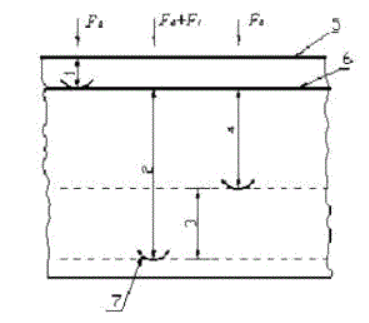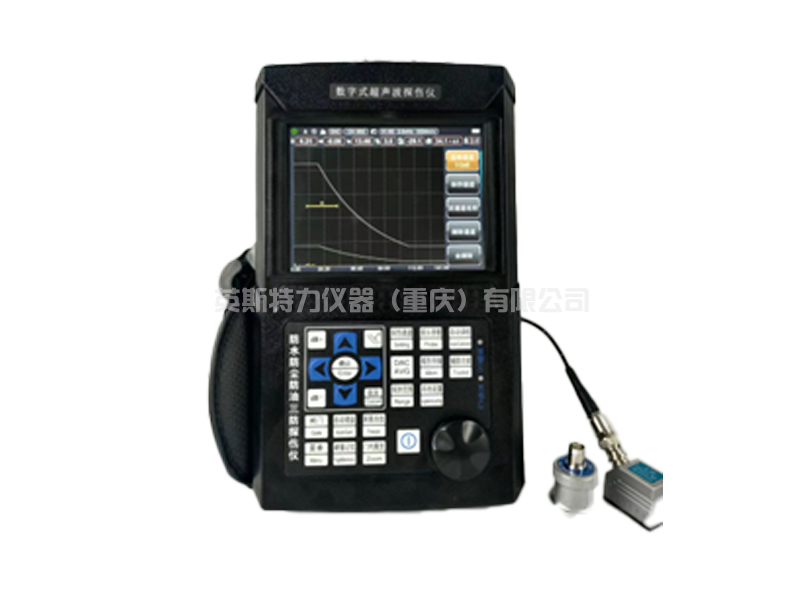2个步骤压入试样表面。卸除主试验力后,在规定条件下,将压头(金刚石圆锥、钢球或球)分在初试验力下测量压痕残余深度h。以压痕残余深度h代表硬度的高低。洛氏硬度试验原理如图2-1所示。

1—在初始试验力Fo下的压入深度;
2一在总试验力Fo+F1下的压入深度;
3—去除主试验力F1后的弹性回复深度;
4—残余压入深度h;
5一试样表面:
6一测量基准面:
7一压头位置
图 2-1洛氏硬度试验原理图
洛氏硬度值按下式计算:
N一常数,对于A、C、D、N、T标尺,N=100:其他标尺,N=130;
h一残余压痕深度,mm :
S一常数,对于,S=0.002mm,对于,S=0.001mm。每一洛氏硬度单位对应的压痕深度,洛氏硬度为0.002mm,表面洛氏硬度为―0.001mm。压痕越浅,硬度越高。洛氏硬度试验分为―2种,一种是普通洛氏硬度试验,一种是表面洛氏硬度试验。洛氏硬度试验采用120°金刚石圆锥和1.588mm D3.175mm钢球三种压头,采用6Okg、100kg、150kg 三种试验力,它们共有九种组合,对应于洛氏硬度的九个标尺,即 HRA、HRB、HRC、HRD、HRE、HRF、HRG、HRH、HRK。表面洛氏硬度试验采用120 0金刚石圆锥和1.588mm钢球2种压头,采用15kg、30kg、45kg 三种试验力,它们共有六种组合,对应于表面洛氏的六个标尺,即 HR15N、HR30N、HR45N、HR15T、HR30T、HR45T。洛氏硬度试验条件如表2一1所示。洛氏硬度标尺的选用如表2一2所示。
N标尺用于类似洛氏标尺C、A和D检测的材料,但仅限于薄小试样和浅硬化深度的试样。
T标尺用于类似洛氏标尺B、F和G检测的材料,但仅限于薄小试样和较软且覆镀层较浅的试样。
洛氏硬度计的特点
洛氏硬度试验操作简单,测量迅速,可在指示表上直接读取硬度值,工作效率高,成为最常用的硬度试验方法之一。由于试验力较小,压痕也小,特别是表面洛氏硬度试验的压痕更小,对大多数工件的使用无影响,可直接测试成品工件,初试验力的采用,使得试样表面轻微的不平度对硬度值的影响较小,因此,此仪器非常适于在工厂使用,适于对成批加工的成品或半成品工件进行逐件检测,该试验方法对测量操作的要求不高,非专业人员容易掌握。
洛氏硬度计的应用
洛氏硬度试验采用了︰3种压头,6种试验力,根据金属材料材质、硬度范围及尺寸的不同,共有15个标尺可供选择,可以测试从很软到很硬几乎全部常见的金属材料,应用范围十分广阔。洛氏硬度计在工业生产中得到了广泛应用,成为检验产品质量,确定合理加工工艺的主要手段。可测试各种黑色和有色金属,测试淬火钢、回火钢、钢、表面硬化钢、各种厚度的板材材料、粉末冶金材料、热喷涂层的硬度。
表面洛氏硬度计用于测试薄板金属、薄壁管材、表面硬化钢和小零件的硬度。
影像测量仪技术基础的基本结构信息由TTC影像测量仪提供。英斯特力仪器是一家集研发、生产及销售于一体的 影像测量仪,拉力试验机, 硬度计 ,探伤仪, 粗糙度仪, 测厚仪, 金相设备厂家, 致力于为客户提供更好的检测仪器。
Two steps are pressed into the surface of the sample. After the main test force is removed, the indentation residual depth h is measured by separating the indentation head (diamond cone, steel ball or ball) under the initial test force under specified conditions. Indentation residual depth h represents the level of hardness. Figure 2-1 shows the principle of rockwell hardness test.
1 - Pressing depth under initial test force Fo; The pressing depth under the total test force Fo+F1; 3 -- Elastic recovery depth after removing the main test force F1; 4 -- Residual pressing depth H; 5 a sample surface :6 a measurement datum :7 a pressure head position
Figure 2-1 Schematic diagram of Rockwell hardness test
Rockwell hardness value is calculated as follows:
N - constant, N=100 for A, C, D, N, T scales, N=130 for other scales;
H - Residual indentation depth, mm:
S is a constant, for S=0.002mm, for S=0.001mm. Each Rockwell hardness unit corresponds to the indentation depth, rockwell hardness is 0.002mm, the surface rockwell hardness is -- 0.001mm. The shallower the indentation, the higher the hardness. Rockwell hardness test is divided into 2 kinds, one is ordinary Rockwell hardness test, one is surface Rockwell hardness test. Rockwell hardness test adopts three indenters of 120° diamond cone and 1.588mm D3.175mm steel ball, and three test forces of 6Okg, 100kg and 150kg are used. There are nine combinations corresponding to nine scales of Rockwell hardness. Namely, HRA, HRB, HRC, HRD, HRE, HRF, HRG, HRH, and HRK. The surface Rockwell hardness test adopts two intakes of 120 0 diamond cone and 1.588mm steel ball, and three test forces of 15kg, 30kg and 45kg are used. They have six combinations corresponding to the six scale of the surface Rockwell, namely HR15N, HR30N, HR45N, HR15T, HR30T and HR45T. Rockwell hardness test conditions are shown in Table 2-1. Rockwell hardness scale is selected as shown in Table 2-2.
The N scale is used for materials similar to rockwell scales C, A and D, but only for thin, small specimens and specimens with shallow hardening depth.
T scale is used for materials similar to Rockwell scale B, F and G, but only for thin and small samples and soft and shallow coating samples.
Rockwell hardness tester characteristics
Rockwell hardness test is one of the most commonly used hardness test methods because of its simple operation and rapid measurement. The hardness value can be read directly on the indicator table with high efficiency. Because the test force is small, the indentation is small, especially the indentation of the surface Rockwell hardness test is smaller, the use of most of the workpiece has no effect, can directly test the finished workpiece, the use of the initial test force, making the sample surface slight roughness of the hardness value of the impact is small, therefore, this instrument is very suitable for use in the factory, Suitable for batch processing of finished or semi-finished work piece by piece inspection, the test method is not high requirements for measurement operation, non-professionals easy to master.
Rockwell hardness tester application
Rockwell hardness test uses: 3 kinds of indenter, 6 kinds of test force, according to the metal material material, hardness range and size of different, a total of 15 scales to choose from, can test from very soft to very hard almost all common metal materials, the application range is very broad. Rockwell hardness tester has been widely used in industrial production, and has become the main means of testing product quality and determining reasonable processing technology. Can test all kinds of black and non-ferrous metals, test hardened steel, tempered steel, steel, surface hardening steel, various thickness of plate materials, powder metallurgy materials, thermal spraying layer hardness.
Surface Rockwell hardness tester is used to test the hardness of sheet metal, thin-wall pipe, surface hardened steel and small parts.







 客服1
客服1 